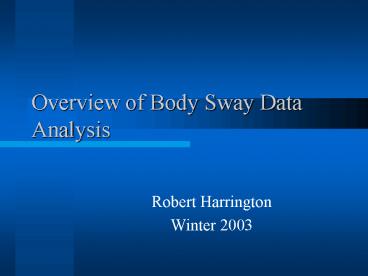Overview of Body Sway Data Analysis - PowerPoint PPT Presentation
Overview of Body Sway Data Analysis
Overview of Body Sway Data Analysis. Robert Harrington. Winter 2003. Goals. Ultimate goal: to determine likelihood of a person's falling by analyzing small ... – PowerPoint PPT presentation
Title: Overview of Body Sway Data Analysis
1
Overview of Body Sway Data Analysis
- Robert Harrington
- Winter 2003
2
Goals
- Ultimate goal to determine likelihood of a
persons falling by analyzing small motion while
standing
FOR MORE INFO...
Prof. David Garelick Northeastern
University 617.373.2936
3
Body Position versus Time
4
Fourier Transform
5
Fourier Transform of Data (cont.)
6
Fourier Transform of Data (cont.)
7
Fourier Transform of Data (cont.)
8
Fourier Transform of Data (cont.)
9
Fourier Transform of Data (cont.)
10
Difficulties with Fourier transform
- No statistically meaningful differences
between fallers and non-fallers - Fixed range of frequencies
- 1/(2?t) to 1/(2?t)
- Does not directly include exponential
damping
11
Proposed Model
- Body can be modeled as a simple spring with the
restoring force proportional to the displacement
at an earlier time - F - k x ( t - ? )
- This model gives solutions which have the form
a e-?t sin(?o t)
12
Laplace Transform
- Allows determination of exponential damping term
- Problem Discrete Laplace Transform very
difficult
13
Laplace Transform graph
14
Laplace Transform (cont.)
15
Laplace Transform problem
- Analytical solution with non-infinite
integration limits gives extra term - Extra term depends on limits AND position in
frequency space - Creates peaks at spurious frequencies
- As limit goes to infinity, peaks converge to one
at the correct frequency
16
Laplace Transform problem
17
Laplace Transform problem
18
Current Status
- Analysis of Fourier peak-widths to determine
exponential damping term - Fitting curves to function, using model to
predict ? corresponding to know Fourier peaks
(parameter ?)
PowerShow.com is a leading presentation sharing website. It has millions of presentations already uploaded and available with 1,000s more being uploaded by its users every day. Whatever your area of interest, here you’ll be able to find and view presentations you’ll love and possibly download. And, best of all, it is completely free and easy to use.
You might even have a presentation you’d like to share with others. If so, just upload it to PowerShow.com. We’ll convert it to an HTML5 slideshow that includes all the media types you’ve already added: audio, video, music, pictures, animations and transition effects. Then you can share it with your target audience as well as PowerShow.com’s millions of monthly visitors. And, again, it’s all free.
About the Developers
PowerShow.com is brought to you by CrystalGraphics, the award-winning developer and market-leading publisher of rich-media enhancement products for presentations. Our product offerings include millions of PowerPoint templates, diagrams, animated 3D characters and more.































